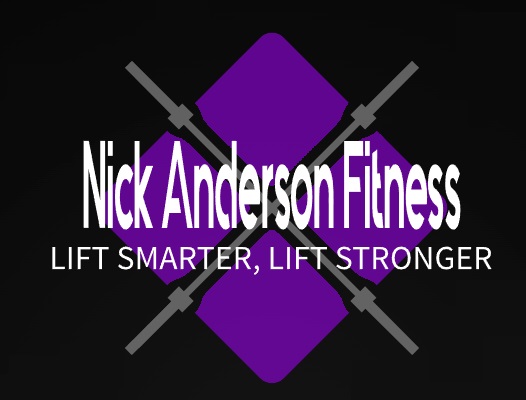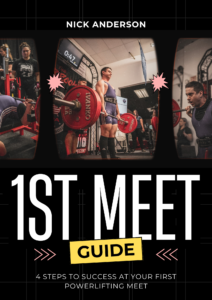
by Nick Anderson | Apr 10, 2024 | Powerlifting
How To Test Your One Rep Max
This comprehensive guide will dive into the nitty gritty of how to test your one rep max in the squat, bench and deadlift.
A 1 rep max (1RM) is the maximum weight that a person can lift in one repetition for a specific exercise.
Knowing what your one rep max is is essential if you’re a seasoned powerlifter, or just getting into, or considering getting into the world of powerlifting.
In this article, we will dive in to:
- Why You Should Test Your 1RM
- How To Work Up To Testing 1RM
- How Often You Should Test Your 1RM
So if you’re ready to find out exactly how strong you are, read on, and don’t skip around.
Why Test Your One Rep Max?
Testing and finding out what your true one rep max is can be extraordinarily beneficial.
Your 1RM provides a baseline for your current strength level.
This allows you to design your training program based on percentages of your 1RM.
Typically, as you go through different phases of your training, you will lift closer and close to your one rep max, at varying rep ranges.
For example, in a hypertrophy phase, you will lift for sets of 6-10 reps, between 60-75% of your 1RM.
While in a strength phase, you will lift for sets of 3-6 reps, between 75-90% of your 1RM.
It can be a great way to tell you how much weight to lift to challenge yourself appropriately, and provide enough training stimulus to make gains.
If you lift too much relative to your 1RM, it leads to fatigue and makes it hard to complete your lifts successfully.
If you lift too low relative to your 1RM, you won’t signal your body to be able to progress to heavier weights.
How To Test Your One Rep Max?
Testing a one rep max can be a daunting task if you’ve never done it before.
There are two key factors you need to understand.
- What your estimated 1RM is
- How to work up to your 1RM to test it.
Once you understand these principles, the guesswork is taken out of it for you, and you just have to execute.
Estimating Your 1RM
If you’ve never tested your one rep max before, you’re probably wondering how you can figure out where to even start.
But there is a very simple calculation, called the Brzycki formula to estimate your one rep max, based on previous weight lifted for a specific number of reps.
Total Weight Lifted in pounds / (1.0278 – (Number of Repetitions x 0.0278)) ≈ 1 Rep Max
You can use this handy tool by strengthlevel.com to estimate your one rep max based on the formula above.
While this formula isn’t 100% accurate, it does give is a good jumping off point for finding a maximum weight for you to shoot for.
Working Up To Your 1RM
Now I know you’re not reading this article, thinking you’re just going to load up the bar to the weight you plan to go for, and just grip it and rip it.
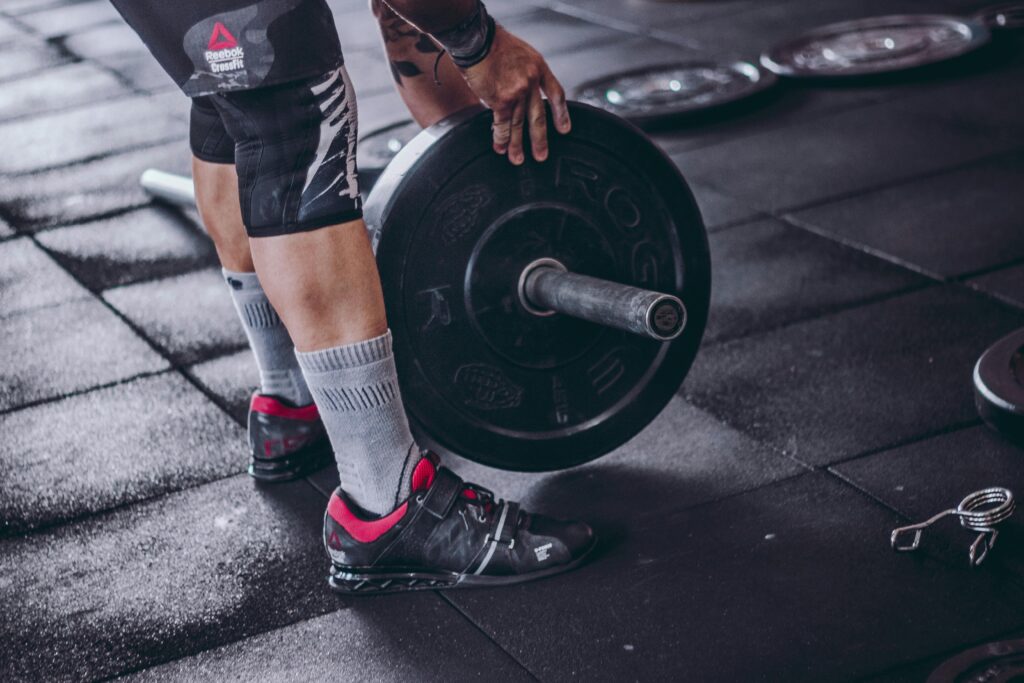
Any good workout involves a period of warming up.
And while you should do a dynamic warmup for mobility, muscle activation, and increasing core temperature, you should also be warming up by lifting weight.
So you should warmup for your one rep max by doing the movement you plan to test your 1RM at lighter, then progressively heavier weights, and progressively lower reps
A general framework for this might look like warming up at 40-50%, 50-60%, 60-70%, 70-80%, 80-86%, 86%-92%, 92-96%.
| Set |
Percentage |
Reps |
Rest |
| 1 |
40-50% |
7-10 |
1-2 mins |
| 2 |
50-60% |
5-7 |
1-2 mins |
| 3 |
60-70% |
3-5 |
2-3 mins |
| 4 |
70-80% |
2-3 |
2-3 mins |
| 5 |
80-86% |
1-2 |
3-5 mins |
| 6 |
86%-92% |
1 |
3-5 mins |
| 7 |
92-96% |
1 |
3-5 mins |
| 8 |
100%+ |
1 |
– |
While this is a great formula, it is only a guide. Some people may feel better with more warmup sets, and some less.
You can adjust this framework based on your own preferences.
Testing: The Fun Part
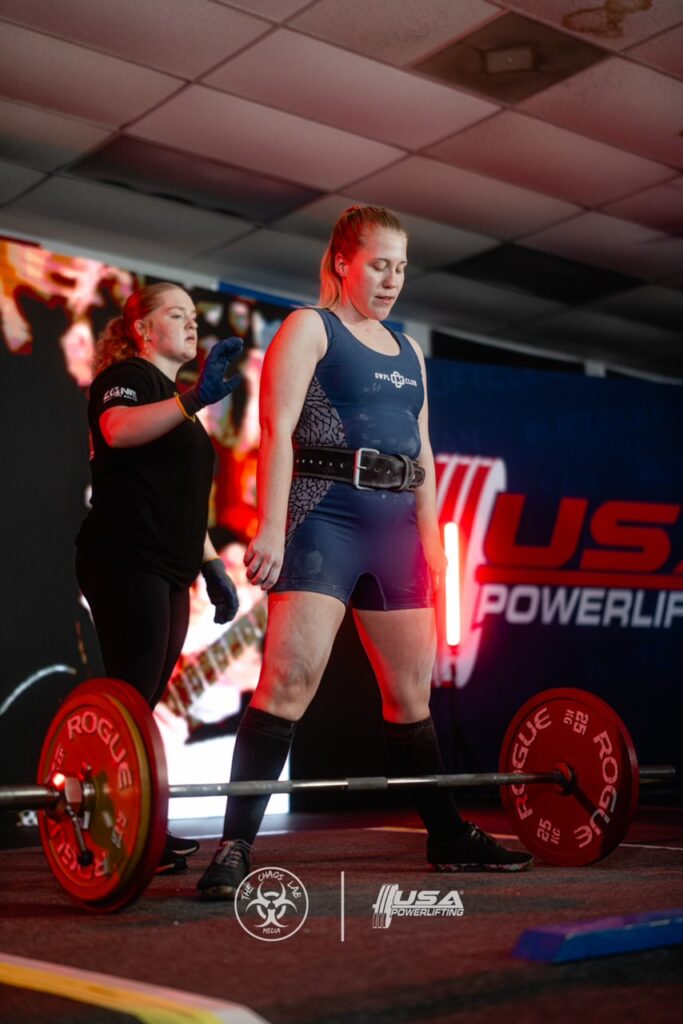
Now that you’ve warmed up to test, it’s now time for both the hardest, yet simplest part.
The moment of truth.
A few key factors to consider before you lay it all out on the line.
- If you haven’t tested your 1RM before, aim for the estimated 1RM based on the Brzycki formula listed above.
- If you’ve tested your 1RM before, don’t waste energy by lifting that weight again as part of your test. Try to beat that today.
- Conversely, don’t try to blow your previous 1 Rep Max out of the water. Aim for 5-10lb or 2.5-5kgs over your previous best. Otherwise you are setting yourself up for failure.
- If you succeed at your attempted weight, and are feeling good, you can try to add another 5-10lbs or 2.5-5kgs.
- If you succeed at your attempted weight, and it was an existential grind to lock it out, do not go for a new PR after that. Take the win, and walk away.
- If you’re able to, get someone to spot you. If you’re not able to, set your safeties, and do a test fail rep with just the bar.
How Often To Test Your One Rep Max
Performing a one rep max is a test of your current strength level.
Think of testing your one rep max like taking a final exam for a chemistry class.
You don’t learn more about chemistry by taking the final exam, it just shows where your current knowledge of chemistry is at that point.
You learn more about chemistry by learning the material, practicing the principles, and studying.
And just like chemistry, you don’t get stronger by performing a one rep max test.
You get stronger by consistently training with challenging weights, by building strength and muscle in different rep ranges, and refining your technique.
Novice lifters, gym bros, and ego lifters train by attempting their one rep max over and over again.
Which is like taking that chemistry exam over and over again without ever once studying for it.
Less Is More
Fatigue
Testing a 1RM is incredibly fatiguing.
This is why after my online coaching clients compete in a powerlifting meet, I give them the entire week off of training afterwards to recover.
Not just physically, but mentally.
Injury Risk
Testing your one rep max also puts you at the greatest risk for injury.
While injuries are not quite as common as people think in strength sports, they happen a lot easier when you don’t train intelligently.
And constantly testing maxes while battling the fatigue that ensues from doing so puts you at greater risk of technique breaking down.
Which ultimately puts you at higher risk for minor to major injuries.
Not Enough Stimulus To Make Gains
Strength is built through the overall volume of your training.
Training volume = Sets × Reps × Weight
So let’s say you’re doing a 1 rep max squat at 300lbs, and it’s a new PR for you.
Your training volume in the squat that day was 1 set × 1 rep × 300lbs = 300lb total training volume.
Now if you were to do 4 sets of 3 squats at 85% of your 1RM of 300lbs…
Your training volume in the squat would be 4 sets × 3 reps × 255lbs = 3,060lbs.
Now you’re accumulating volume to make gains!
How Often Should I Test?
There’s no hard and fast rule as to how often is too often, and how infrequent is too infrequent.
In my opinion, the minimum amount of time you should wait to test your 1 rep max is 12 weeks.
This gives you enough time to periodize your training.
You can go through a phase of lifting lower weights for higher reps with the goal of increasing muscle size and building work capacity for heavier weights down the line.
You can then go through a phase of higher weights for lower reps, with the goal of increasing strength in your main lifts.
And finally, if you’re choosing to test 1RMs, you can go through a phase of lifting near maximal weights for sets or 2 and 1, with the goal of lifting heavy weight and increasing neural adaptations to execute maximal lifts efficiently.
You can then repeat the cycle anew. But ideally, you’d skip a few peaking phases, incorporate different movements, and take deloads.
Thus making your 1RM testing spaced out further than 12 weeks, and not testing for 6-12 months while you really dedicate time to building strength for maximal strength gains.
There is a lot of nuance to the above phasing, and if that overwhelms the hell out of you, it’s understandable.
Navigating the intricacies of proper periodization and avoiding overtraining can be a challenge. That’s where I can help.
My online coaching program takes the guesswork out of your training. I’ll design a personalized program that incorporates strategic phases like hypertrophy, strength, and peaking blocks, just like the 12-week example provided.
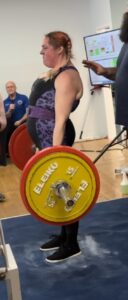 Here’s what you’ll get:
Here’s what you’ll get:
- Customized Training Plans: Programs tailored to your goals, experience level, and equipment availability.
- Periodization Expertise: Structured training phases to optimize muscle growth, build strength, and peak for 1RM testing.
- Form Analysis and Technique Cues: Ensure you’re lifting safely and maximizing your results.
- 24/7 Support: Get expert guidance and motivation whenever you need it.
Let me help you reach your strength training goals efficiently and safely. Ready to take your lifting to the next level?
Click here to learn more about my online coaching program!
Conclusion
Testing your 1RM can be a valuable tool, but it’s a means to an end, not the end itself.
Consistent training with challenging weights and proper form builds true strength.
However, testing your 1RM every few weeks can be counterproductive due to fatigue and injury risk.
Aim for an absolute minimum of 12 weeks between tests, but ideally 6-12 months will elicit the most change.
This guide provided a framework for testing your 1RM, including:
- Warm-up sets: Gradually increase weight and decrease reps to prepare your muscles and nervous system.
- Estimated 1RM: Use the Brzycki formula to get a starting point.
- Attempting your 1RM: Focus on good form and aim to beat your previous attempt by a small margin (5-10lbs).
But remember, testing too frequently has downsides:
- Fatigue: 1RM testing is demanding, requiring ample recovery time.
- Injury risk: Constantly pushing limits can lead to injuries if proper technique suffers.
- Limited training stimulus: 1RM attempts don’t provide enough overall training volume for optimal strength gains.
This can feel overwhelming, especially navigating the intricacies of periodization.
That’s where my online coaching program comes in. I’ll take the guesswork out of your training and design a personalized program tailored to your goals and experience level.
Ready to take your lifting to the next level? Click here to learn more about my online coaching program!
In the meantime, happy lifting.
Nick
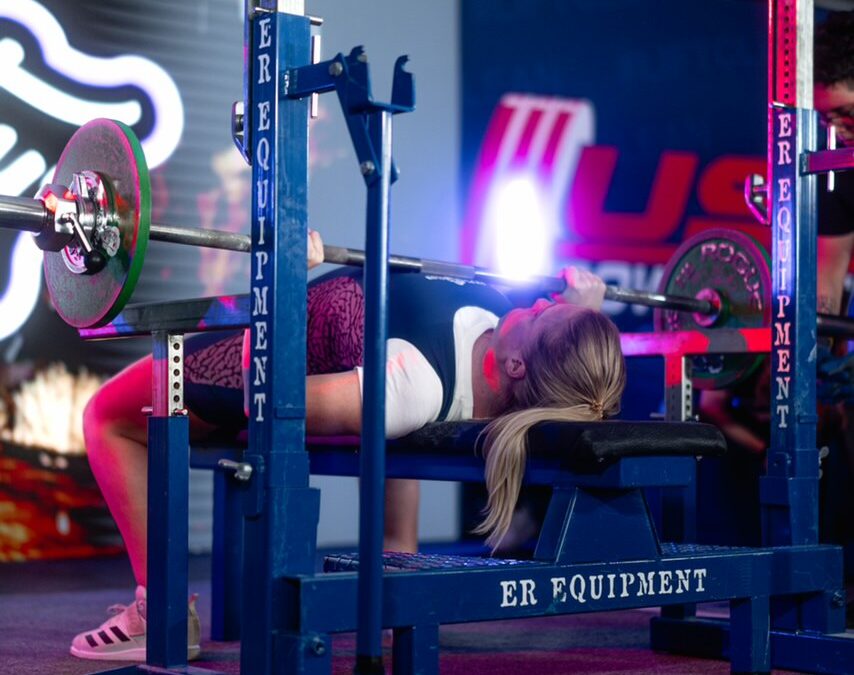
by Nick Anderson | Apr 1, 2024 | Powerlifting
Finding the right bench press grip width can make all the difference in the strength of your press.
Beneath the surface level straightforwardness of the bench press lies a world of nuance.
From grip width to bar path, even minor adjustments can unlock hidden potential in your pressing power.
Your bench press journey is a continuous quest for optimization.
As you gain strength and experience, what works best for your body might evolve.
While fundamental form principles exist, individual differences play a significant role.
This is where bench press grip width enters the picture, a seemingly simple detail with far-reaching consequences.
Understanding Bench Press Grip Widths
To better understand which bench press grip width is right for you, we must first define what constitutes a close, moderate and wide grip.
Close Grip – Index finger on inner edge of knurling to halfway to knurl marks
Moderate Grip – Index finger halfway between knurling inner edge and knurl marks to ring fingers on knurl marks
Wide Grip – Ring fingers on knurl marks to index finger on knurl marks
Any wider than index fingers on knurl marks and it is outside of the maximum grip allowed for most powerlifting federations
Close Grip Bench Press
As mentioned above a close grip bench press is when your index fingers are between the inner edge of the knurling to halfway to knurl marks, and all ranges in between.
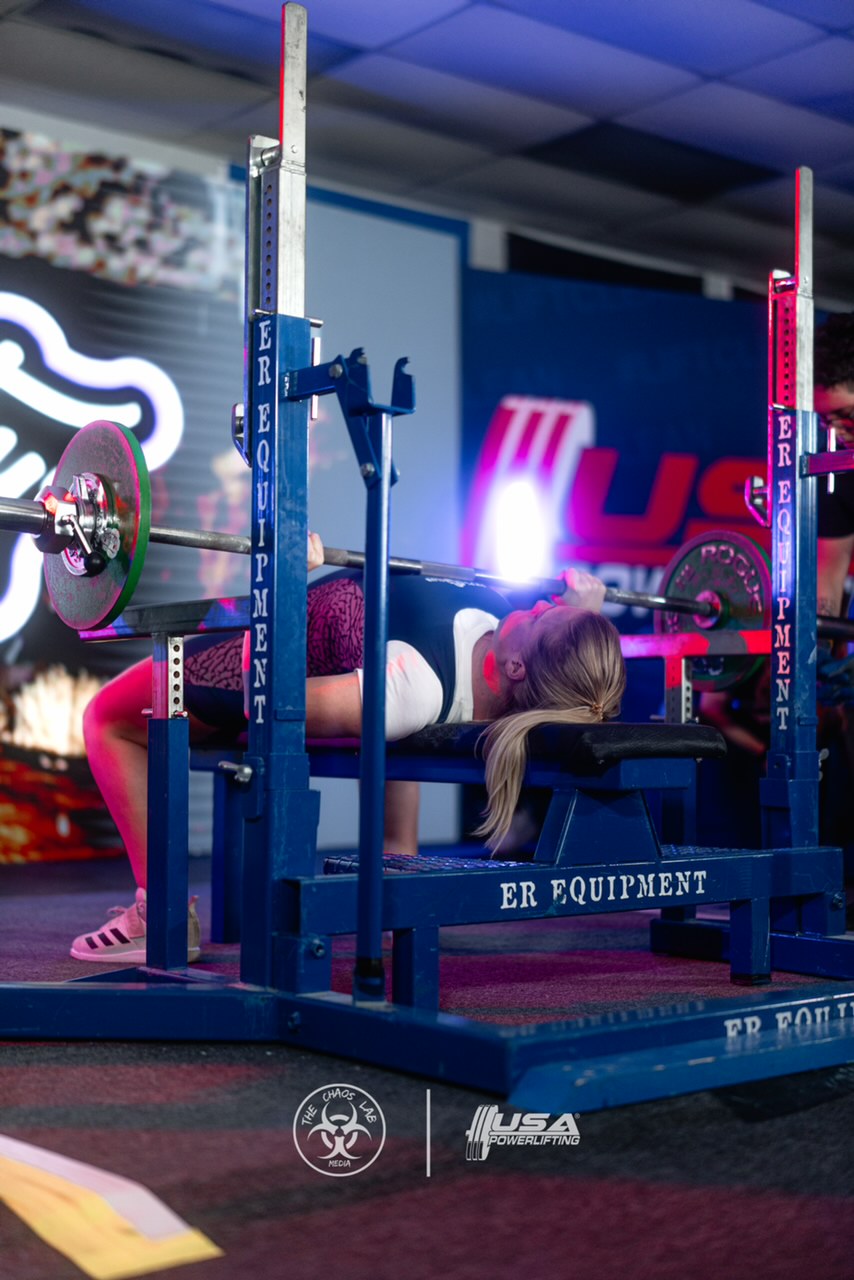
Potential Benefits
Accessory Muscle Development
The close grip bench press increases the activation from your triceps.
The narrower hand placement forces the elbows to bend more, and the increased elbow flexion creates a targeted stimulus for tricep growth and strength.
Strong triceps are essential for powerful bench presses, and the close grip provides a direct path to achieving that goal.
If you wanted bigger triceps, you could just to tricep extensions, or tricep pushdowns until your elbows cried uncle.
While doing tricep pushdowns on a cable machine does have benefits, there’s a difference between that and actually putting a barbell in your hand and strengthening your triceps by doing the movement pattern you need to do in competition.
The close-grip bench press isn’t a tricep isolation exercise in a vacuum.
It engages your engages your anterior delts (shoulders), pecs, and core to stabilize the movement.
Strengthening these accessory muscles contributes to overall stability and power transfer.
Improved Technique
The close grip acts as a form check for your lats.
The narrower grip forces you to actively engage your lats, which is essential for maintaining proper elbow tuck and preventing elbow flare.
By maintaining your elbows tucked closer into your sides, this helps you activate your lats, which is crucial to a strong bench press.
You can immediately feel if your elbows flare to wide, as your lats will become more disengaged and you’ll struggle to maintain a stable barbell through the movement.
By using close grip (whether it is your preferred position or not), you can refine your setup and bar path for a more efficient and safer competition bench press.
Addressing Weaknesses
The close grip press can expose a weakness in your lockout strength, a common sticking point for many powerlifters.
If your bench press tends to fail at the top half towards lockout, you can address this weakness by increasing the strength of your triceps.
Reduced Training Stress
The close-grip press allows you to work on pressing mechanics and tricep strength without putting the same level of stress on your shoulders and central nervous system compared to a heavy competition bench press.
Potential Drawbacks
Increased Range of Motion
The close grip bench press forces you to have to tuck your elbows in closer to the sides.
This has an effect on where the bar touches on your chest, which is generally further down the chest than with the moderate or wide grip bench.
Since your bar path changes to a lower point, the bar has to travel a further distance.
Powerlifting is a sport where every inch matters, so the further distance could potentially have an impact on how much weight you can lift
Increased Stress on Wrists and Elbows
Beginner lifters tend to complain about wrist pain with the close grip bench.
This can be just a simple technique issue, as the wrists tend to hyperextend to compensate for the increased range of motion.
But in beginner lifters, it can also be because the wrist joint hasn’t built up enough stability to maintain position under load.
The elbow can also tend to get worn down over time, as the range of motion at the elbow is significantly greater in the close grip bench.
Increased Stress on Shoulders
For some lifters, keeping the elbows in can bother their shoulders.
For others, it’s perfectly fine, and actually feels better on their shoulders than anything.
This is a highly individualized topic, and you are the only person who can determine which feels best for you.
Biomechanics
Elbow Angle
With the close grip bench press, it’s beneficial to overemphasize how much you tuck your elbows.
Keeping the elbows in tight keeps your elbows directly under your wrists while your hands are in closer.
Touchpoint
As you overemphasize your elbow tuck, the point where the bar touches your chest will change to a lower spot.
You’ll likely aim for under the bra line, or the upper edge of the abdomen.
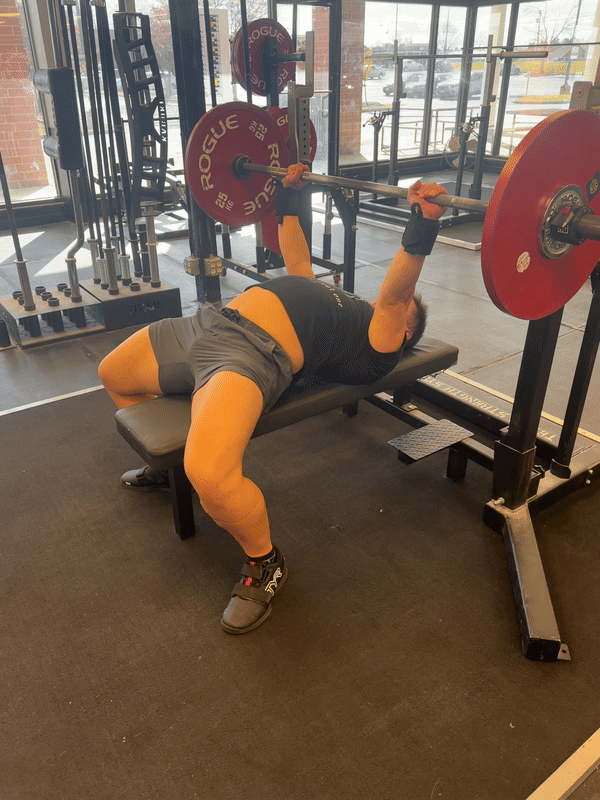
Moderate Grip Bench Press
A moderate grip is the range between your index finger halfway between knurling inner edge and knurl marks, to ring fingers on knurl marks

Potential Benefits
More balanced
For most lifters, the moderate grip bench press is the golden standard.
It offers a balanced approach, engaging your chest, triceps, and shoulders fairly uniformly.
This translates to efficient movement patterns, maximizing your strength potential, while allowing for a straightforward bar path and chest touchpoint.
Unlike its extreme counterparts, the moderate grip avoids the pitfalls of the close grip and wide grip.
More natural movement pattern
If you were to push a car, you’d probably take a moderate hand width.
You wouldn’t flare out super wide, or keep the hands in super close.
The moderate grip bench press is the most natural path for your body to take.
It allows for natural and sustained lat tension.
This translates to better back support and stability throughout the lift, minimizing the risk of injury and maximizing your ability to move heavier weights.
This also helps you maintain a strong core and upper back engagement throughout the entire movement.
More sustainable long term
While some lifters might experiment with extreme technique variations, these often prove unsustainable in the long run.
The key lies in finding the a bench press grip width and body position that allows for efficient movement mechanics, and minimized risk of injury.
This allows you to train consistently for months, progressively building strength over time.
Of course, there are exceptions.
Elite athletes and individuals with unique body types might find success with more unorthodox techniques.
But for most lifters, focusing on more of a middle ground in technique is the path to consistent and sustainable progress.
Moderate Range of Motion
By keeping your hands wider than the close grip, the range of motion will be less than the close grip.
However, it will also be more than the wide grip.
Biomechanics
Elbow Angle
Unlike the close grip counterpart, the elbow is not going to tuck in close to the sides.
And unlike the wider grip bench, the elbows won’t flare out wide.
The moderate grip is all about the balanced point in between the two.
Remember, your best elbow angle is going to stack the elbow joint directly underneath the wrist in a vertical line.
Once you lose that joint stack, that’s where inefficiencies shine through.
Touchpoint
The touchpoint will be much higher in the moderate grip press than the close grip.
For most people, it will be somewhere on the lower end of the breastbone, very near the nipple line.
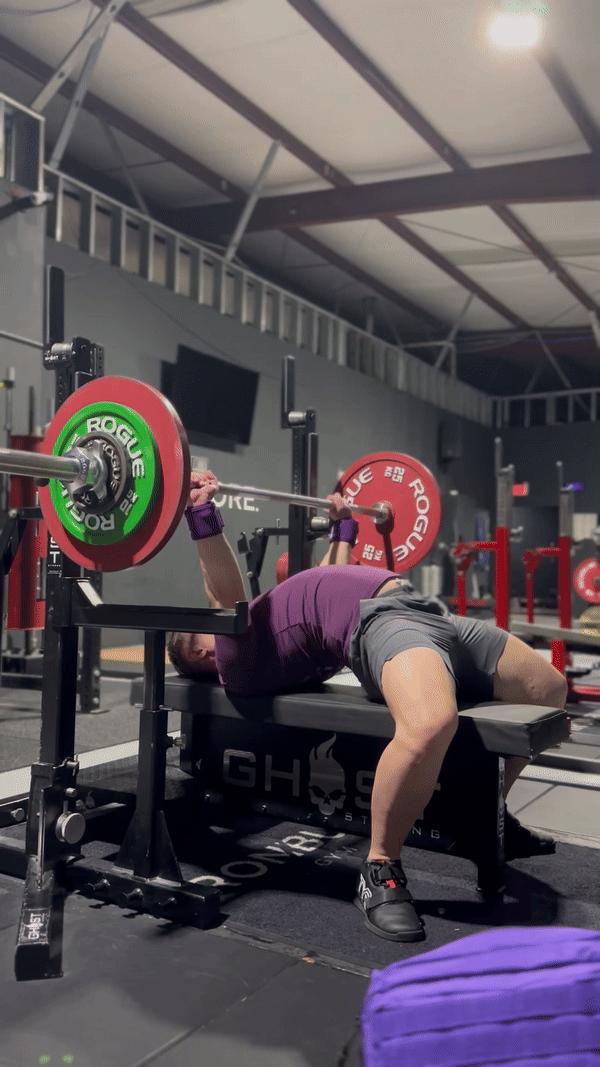
Wide Grip Bench Press
A wide grip is defined as ring fingers on knurl marks to index finger on knurl marks. Anything wider than this is against the rules of most powerlifting federations.
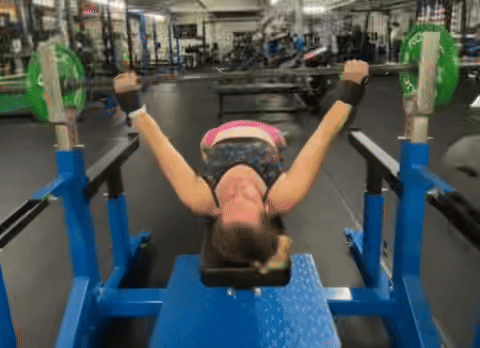
Potential Benefits
Reduced Range Of Motion
Due to the wider hand placement, the bar travels a shorter distance during the wide-grip bench press.
This can be beneficial for lifters with limitations in their shoulder mobility or those recovering from injuries.
It also allows you to potentially lift heavier weights because you’re moving the weight through a shorter distance.
Higher Pectoral Activation
The wide bench press grip width emphasizes chest muscles to a greater degree compared to a narrower grip.
This can be valuable for strengthening these specific portions of the chest, contributing to a stronger overall pressing motion.
The chest is a larger muscle than the delts or the triceps that are more involved in the moderate to close grip options, so it has potential for more strength.
However, there is serious benefit to recruiting muscles to help your chest out in the bench press.
Decreased Stress On Shoulders
When proper elbow tuck is maintained with a wider grip, it can theoretically decrease stress on the shoulder joints compared to a close-grip bench press.
This allows powerlifters to focus on maximizing bench press strength without excessive shoulder strain.
Potential Drawbacks
Increased Stress On Shoulders
But I just said that it can decrease stress on your shoulders didn’t I?
While a wider grip can theoretically decrease stress on the shoulder joints compared to a close-grip bench press when proper elbow tuck is maintained, shoulder pain can still occur in many different positions.
A close grip can irritate them by angling the arm in.
A wide grip can irritate them by angling the arm out.
This is highly individual, and the only person who knows which position (if any) causes discomfort is you.
Maintaining and improving shoulder mobility is helpful for all grip variations.
This helpful guide discusses various exercises to improve mobility for powerlifters, which can benefit your pressing technique across the board.
Heavy Reliance On Pec Strength
The wide grip requires significant chest strength to lift heavy weight.
If you don’t have a disproportionately strong chest, this may not be the grip for you.
Biomechanics
Elbow Angle
To maintain keeping your wrists and elbows in a vertical line, the elbows will have to flare out wider.
Touchpoint
The touchpoint for the wide grip will be the higher of the three options.
You should be hitting higher on the pec, above the nipple in this position.
Choosing Your Competition Bench Press Grip Width
Now that we’ve explored the close, moderate, and wide grip bench press variations, it’s time to find your ideal competition bench press grip width.
This sweet spot maximizes your strength potential while minimizing risk of injury over the long term.
Here’s how to navigate this decision:
Start Moderate, Tailor Later
For most lifters, a moderate grip width is the starting point.
It provides a balanced activation of your chest, triceps, and shoulders, leading to efficient movement patterns and a straightforward bar path.
This “middle ground” approach minimizes the drawbacks of the extreme close and wide grip variations.
Ready to take your bench press training to the next level and compete in your first powerlifting meet? My
free guide, First Powerlifting Meet Guide: 4 Steps to Success at Your First Powerlifting Meet, walks you through everything you need to know. From demystifying the rules and competition format to developing a strategic warmup and fueling plan, this guide equips you to approach meet day with confidence and perform at your peak.
Download your free copy now and ensure a smooth and successful competition experience!

I like to use pinky fingers on the knurl marks as a starting point for the lifters I coach, and then from there we can tinker.
Generally, I have them play around with one finger width at a time for different setup.
I’m not going to take them from pinkies on the knurl marks to all the way to index fingers on the knurl marks in one go.
It’s best to experiment with grip widths little by little.
General Guidelines (Not Rules)
Long Arms & Mid-Range/Lockout Sticking Point
If you have longer arms and struggle with sticking points in the mid-range or lockout with a moderate grip, a slightly wider bench press grip width might be beneficial.
This shortens the range of motion, allowing you to potentially grind through those sticking points.
Shorter Arms & Off-the-Chest Sticking Point
Conversely, lifters with shorter arms who struggle to get the bar off their chest with a moderate grip might find some success with a slightly closer grip.
This allows for a more natural pressing motion and potentially a stronger start to the lift.
Beyond Arm Length – Individuality Matters
These are just general guidelines. Injuries, shoulder mobility, and personal preference all play a significant role.
Experiment with different bench press grip widths during training sessions to see what feels strongest and most stable for you. Pay close attention to:
- Pain-Free Pressing: The most important factor is pain-free pressing. If a specific grip width causes discomfort, it’s probably not your best position.
- Efficiency and Stability: Choose a bench press grip width that allows you to maintain proper form throughout the entire lift. This includes keeping your core engaged, back tight, and elbows tucked in at an appropriate angle. If your technique isn’t perfect right off the bat, that’s normal.
- Bar Path and Touchpoint: The grip width will influence your bar path and touchpoint on your chest. Find a combination that feels natural and allows for a powerful pressing motion.
There’s no “one size fits all” answer.
While some elite powerlifters might find success with very wide or close grips due to unique body types, most athletes will find their power zone within the moderate grip range.
Focus on finding a bench press grip width that allows you to press safely, efficiently, and with maximum strength potential.
Incorporating Varying Grip Widths In Training
While you’ve honed in on your competition bench press grip width, incorporating other variations into your training offers strategic benefits:
Close-Grip Bench for Triceps and Lockout Strength
The close-grip bench press serves as a fantastic secondary bench press exercise.
By placing more emphasis on your triceps, it can help you address weaknesses in lockout strength, a common sticking point for many powerlifters.
Think of it as targeted training for that crucial lockout phase of your competition bench press.
Wide-Grip Bench for Off-the-Chest Strength
The wider grip variation can be a valuable tool for developing strength off the chest.
This can be helpful for lifters who struggle to initiate the press with a moderate grip.
However, remember that the wider grip can be more stressful on the shoulders.
Offseason Grip Variation Training
During the offseason, when competition intensity isn’t the primary focus, incorporating wider and closer grip variations into your training program can be beneficial.
This allows you to explore different movement patterns, build overall upper body strength, and potentially identify new areas of strength development that can translate back to your competition grip later.
Conclusion: The Nuance of Grip Width
The bench press might seem simple, but grip width plays a surprising role in maximizing your strength and safety.
Experiment with close, moderate, and wide grips to find your personal sweet spot.
There’s no one-size-fits-all answer, so listen to your body and prioritize the grip width that feels best and strongest for you.
Utilize different grip variations strategically to target weaknesses and build well-rounded pressing power.
Ready to translate your newfound bench press grip width knowledge into a dominant competition performance?
Don’t navigate meet day alone!
My free guide, First Powerlifting Meet Guide: 4 Steps to Crushing Your Competition Debut, equips you with the tools and strategies to conquer every aspect of your first powerlifting meet.
From demystifying competition rules to developing a strategic warmup and fueling plan, this guide sets you up for a confident and successful experience.
Download your free copy today!
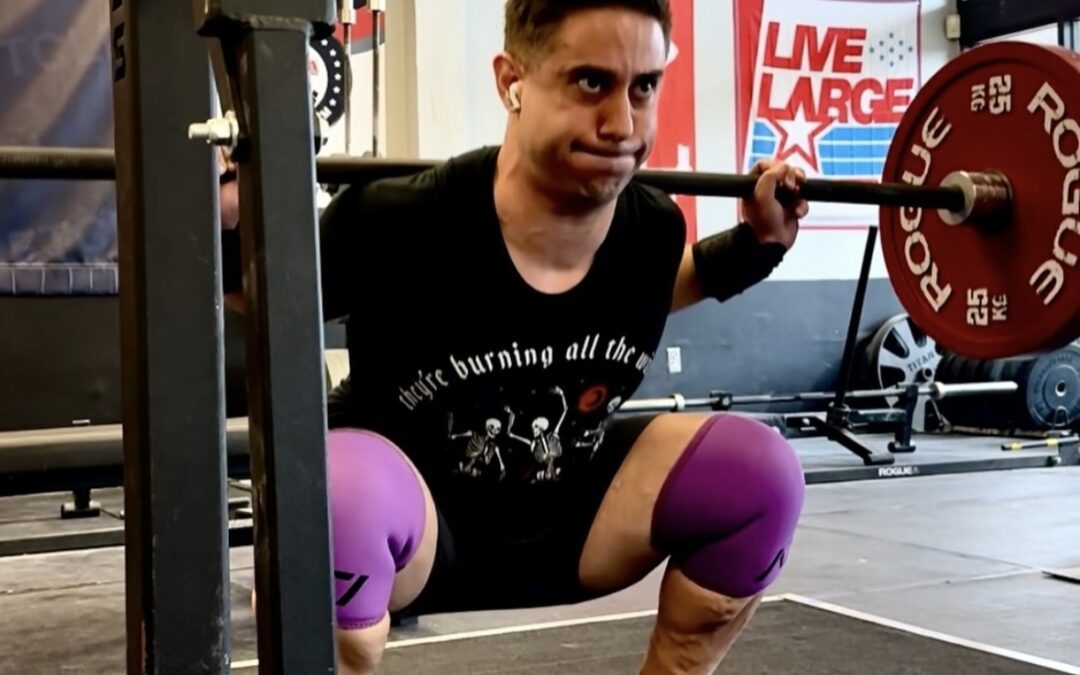
by Nick Anderson | Jan 30, 2024 | Powerlifting
Do you want to learn how to barbell back squat? You’ve come to the right place.
This is the most comprehensive guide on how to barbell back squat on the internet.
Whether you’re just getting into the gym for the first time, or you’re a competitive powerlifter.
I’m going to teach you everything you need to know about the barbell back squat.
You’ll learn how to do it in the safest possible manner so you don’t hurt yourself.
You’ll learn how to use it to build the most amount of muscle.
And you’ll learn to use the most optimal technique so you can lift as much weight as possible.
By the end of this article, you’ll know how to squat like a pro.
How To Do A Barbell Back Squat: A Step By Step Guide
Step 1 – Put the bar in the rack
Okay, no shit, Nick. Put the bar in the rack.
Obviously, but there is some nuance to it, and I want to make sure you get it right.
The height of the bar is everything.
It can be the difference between setting a massive personal record where everyone in the gym applauds.
And getting stuck at the bottom of the squat, and reaching frantically for your LifeAlert.
If you set the bar too high, you’ll have to get on tippy toes to get the bar out.
You don’t want to be standing on your toes with a lot of weight on your back.
Conversely, you don’t want to set up too low, as you’re wasting energy by already doing a partial squat just to get the bar off the rack.
When you set the bar up in the rack, you should be able to reach your hands out the bar, and your arms will be perfectly straight.
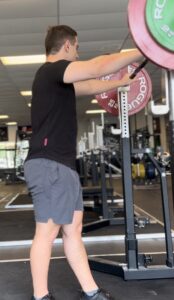
Not all squat racks will allow you to do this, as some have more space between height settings than others.
So whichever you can get closest to this position will generally work best.
But as a general rule, setting the bar too low is safer than setting the bar too high.
Step 2 – Get Under The Bar
Another obvious one, how are you going to barbell back squat without getting under the bar?
But again, there’s nuance to this, and it is arguably the most important piece of the barbell squat.
This is where you’ll initiate your setup, which is paramount.
So face the rack, and we can begin our setup.
Do not under any circumstances face away from the rack.
Otherwise, when you have to re-rack the bar later, you’re not going to be able to see the hooks, and you’ll have a much harder time reracking.
Shoulder Mobility
Start by putting your hands on the bar.
Where your hands can go will be dictated by your shoulder mobility.
The more mobile your shoulders are, the closer to the center of the bar your hands can go.
The less mobile your shoulders are, you’ll have to take a wider grip.
Ideally, you will want to have your hands as close as the mobility of your shoulders will allow.
This will allow you to create the most tension through your upper back to transfer force into the bar.
As long as your hands stay outside of your elbows once you get under the bar.

Where to place the bar on your back
Duck your head under, and get your shoulders under the bar.
You now have two options.
The high bar, or the low bar squat.
I’ll talk more about these later, but for now I just want to introduce how to setup.
For the high bar back squat, you’re going to place the bar across the top of your shoulders.
For the low bar back squat, you’re going to place the bar across your rear delts.
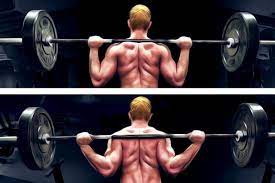
Step 3 – Get Tight
Now that you’re all cozy under the bar, it’s time to get uncomfortable.
The key here is to get everything in your body as tight and squeezed as possible.
The first thing I want you to think about doing is pinching your shoulderblades together, then down.
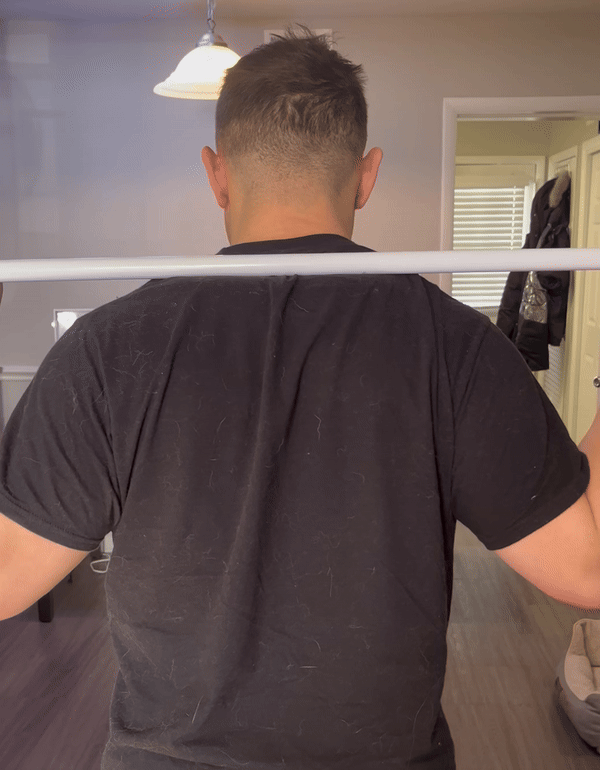
This is going to create a nice stable shelf for the bar to stay on the entire time.
Secondly, I want you to think about drawing your elbows back to your midline, then tuck them under you.
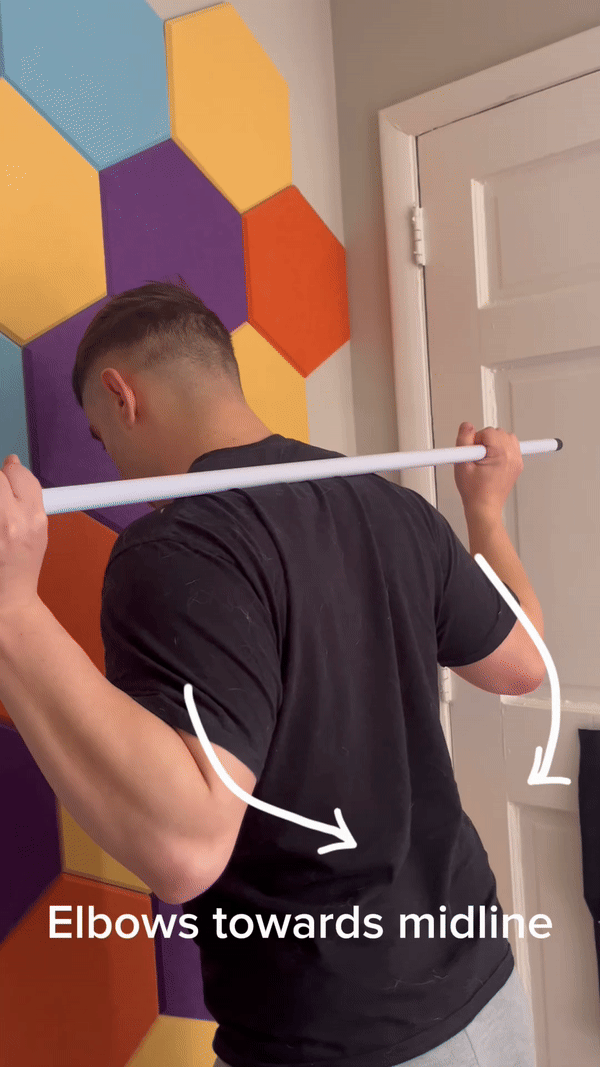
This is going to help engage the rest of your upper back and your lats.
The more muscles you have engaged, the less potential there is for energy to transfer into the bar, than leak out and cause your body to have to compensate elsewhere.
Step 4 – Walk Out
Now that you’re all nice and tight, it’s time to take this barbell for a ride.
Keeping everything tight and squeezed back towards your midline, stand all the way up, and take one step directly back behind you.
Many people will start stepping back and out to get their feet into their ideal position on the first step, but in my opinion, this is a huge mistake.
It leaves the potential for you to be off balance on your initial walkout.
And even worse, it also leaves potential for you to accidentally hit the rack with the bar, which will take you really off a balance.
So the first step to a good walkout is a single step straight back.
From here, you can step your opposite leg back and out to the side at an angle to set into your ideal stance width.
With your third and final step, step to the side to get even.
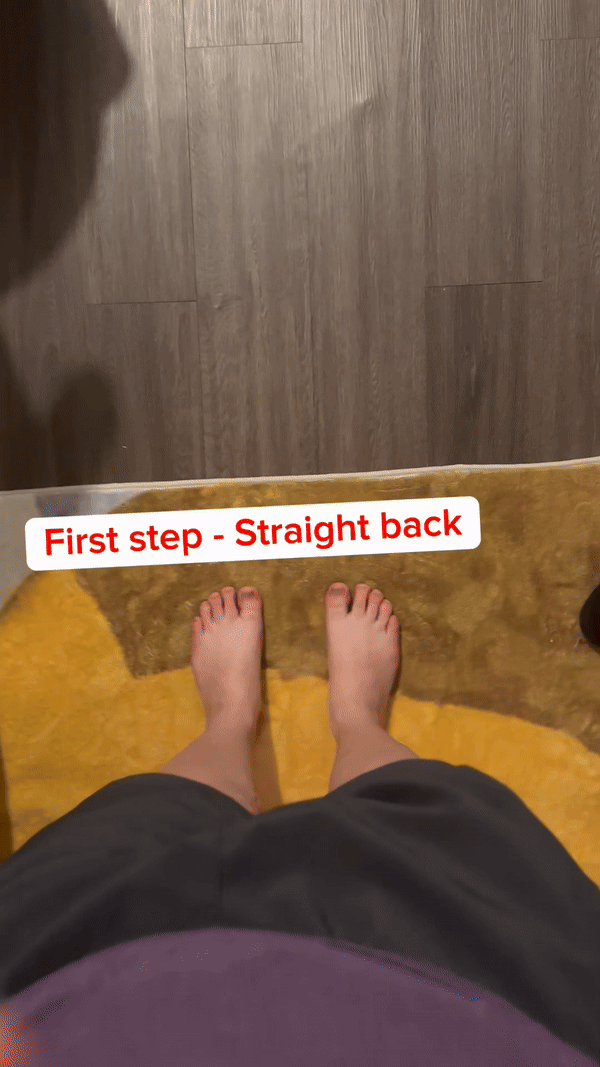
Setting your stance width
Just like your hand width on the bar, stance width is going to come down to individual variability.
The width of your stance will be dictated by factors such as ankle mobility, hip mobility, and limb proportions.
While there will always be exceptions to this rule, choosing either a super narrow, or a super wide stance is usually not ideal for most people.
Most lifters will feel most comfortable squatting with their feet slightly wider than hip width apart.
If you’re not sure of your most comfortable stance width, it is a great starting point.
As you continue to practice the squat, you can play with this position and test whether wide or more narrow than hip width feels better for you.
Make sure that when you play with your hip width, the angle of your toes follow the same angle as your knee.
For example, as you start to widen your hips for a wider stance squat, your toes will have to turn out to match the knee angle
And with a more narrow stance, your toes will have to turn more straight to match the knee angle
This image from an article by Barbell Rehab helps illustrate this point nicely
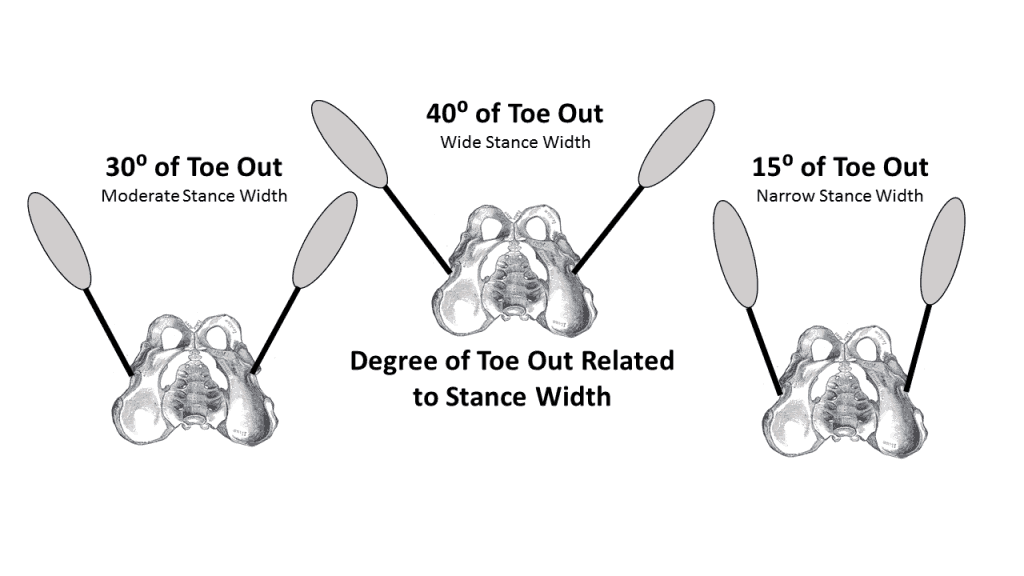
Step 5 – Breathing and Bracing
While this is one of the most important pieces of your squat, I’m not going to spend too much time on breathing and bracing.
Reason being, this could be it’s own separate article. In fact it is it’s own separate article entitled How To Brace Your Core For Lifting, which I highly recommend you read.
I’ll give you the too long didn’t read version in this article.
The foundations of a good barbell back squat comes from a giant breath in, and a big brace of your abdominal muscles.
The first step is to fill your body with as much air as possible.
Then brace your core by pushing your abdominal muscles out, like someone is about to punch you really hard in the stomach, and you’re bracing for impact.
The key is to get 360° of expansion across your entire midsection.
This is going to create intra-abdominal pressure, which causes your diaphragm to contract and press down into the empty space of your abdominal cavity, and creates pressure to support and stabilize the spine.
A good brace gives you not only your strongest lift, but your safest lift too.
If bracing isn’t a concept you’re all that familiar with, I’m going to reiterate the importance of reading How To Brace Your Core For Lifting.
Step 6 – Squat!
We finally got there, through a long series of setup, it’s time to squat.
You’ve got everything nice and tight, and you’ve braced the hell out of your core, your next step is to sit down into the squat.
Getting The Joints Working Together
Since the squat is a multi-joint movement, it’ll be necessary for you to move multiple joints at the same time (duh).
The reason I make this glaringly obvious statement, is with beginner squatters, or squatters with bad habits, I have seen the joints not move at the same time, but in series, one after the other.
The main joints involved in the squat are the ankle joint, the knee joint, and the hip joint.
As you descend, your hips move into flexion.
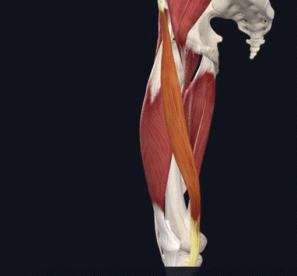
Your knees move into flexion.
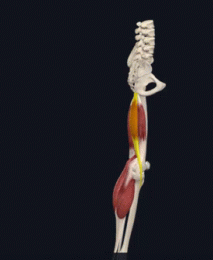
Your ankles move into dorsiflexion.
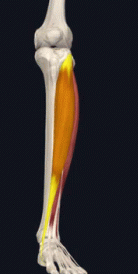
All three of these actions have to take place at the exact same time, otherwise, other muscles will take over, leading to a less efficient, and less safe squat.
The way that I like to cue lifters to get all these joints moving at the same time is to imagine a rope attached to each of these joints, pulling you in the direction needed.
Imagine a rope around the back of your ankles, pulling you forward.
Imagine a rope around the back of your knees, pulling you forward,
And imagine a rope around the front of your hips, pulling you backwards.
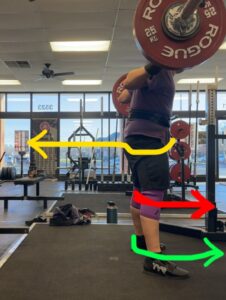
Tripod Foot
As you’re sitting down into the squat (and as you ascend as well), I want you to think about the tripod foot.
Which is not when a third foot comes out from your ass to help you balance.
It is maintaining equal pressure across three points of contact through your feet, the heel, the base of the big toe, and the base of the little toe.
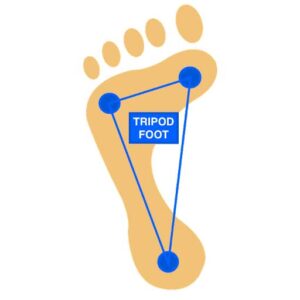
The first link in the chain of the squat is your feet.
Maintaining equal pressure across these three points of contact enhances the stability of your squat all the way up the chain.
So before you initiate your descent, I want you to first think about bringing attention the heel, the base of the big toe, and the base of the little toe.
If you are too far forward in your toes, your bodyweight will shift forward, causing you to be off balance.
And if you are too far back in your heels, your bodyweight will shift backwards, causing you to fall on your ass.
Focusing on these points distributes the pressure evenly through your feet, and brings force through the center of your foot, which is your center of mass.
Squat Depth
How deep you should squat depends entirely on the goals of your squat.
A full depth squat, according to the rules of powerlifting, is to get the crease of your hip lower than the top of your knee joint.
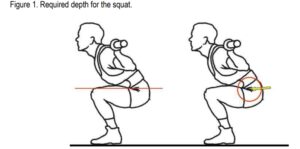
The above image credit from the USAPL Rulebook.
And if you are a powerlifter, or have aspirations to become a powerlifter, then you need to be able to hit this depth.
Non-powerlifters don’t necessarily need to squat this low, but there are several benefits to squatting this low.
If you can squat this low, without any pain, it is going to build up a lot of strength in your knee joints, and they will become healthier over time.
If you cannot squat this low without pain, you may be able to work up to it if you are following a good program, and under the guidance of a qualified coach.
You also might not be, and squatting to whatever depth your body can tolerate is perfectly acceptable, and still has great benefits.
Descend as quickly as your body can handle
Getting a good barbell back squat involves getting in quick and getting out quick.
The more time that you spend under the bar, the more tension from the weight is going to be placed on you, thus making the squat harder.
Now when I say that, many people initially think it means to dive bomb down into the squat at high speed.
For some of you, yes. For most of you, no.
I want to stress that I mean for you to go as quickly as you can handle.
Let’s use two examples of two of my online coaching clients and powerlifting athletes, Sahara, and Kate.
Example 1: Sahara
In the first example, Sahara is known to squat with what she describes as “lightning speed.”
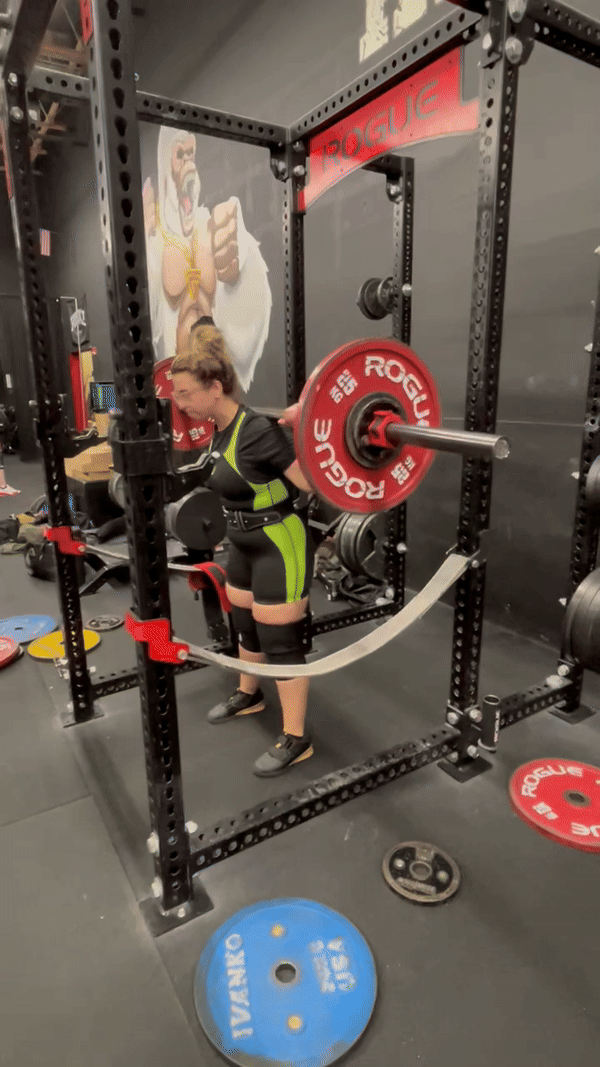
The reason for this is Sahara has really good balance.
She is evenly balanced in her limb lengths, which allows her to squat quickly without her technique breaking down.
Sahara also works in a group fitness setting, and is used to squatting quickly.
This makes her an outlier in how fast she squats.
Example 2: Kate
In the second example, we have Kate, you can see she moves much slower.
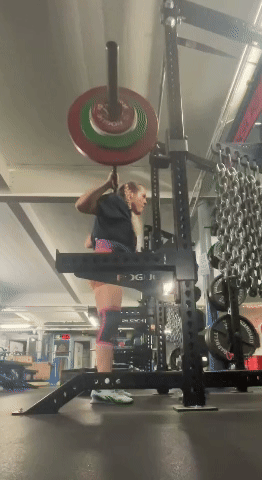
Since her limb lengths are less proportionate, and she has a longer upper leg compared to her lower leg and torso, it becomes difficult for her to squat as quickly (we will touch on the topic of limb lengths much more in depth later).
She also has tighter hips, making getting into the deepest position mare challenging.
If Kate we to try to squat down as quickly as Sahara, she would likely lose her balance, or lose tension somewhere through her body.
So she squats as quickly as her technique will allow, while still maintaining good technique.
Both Kate and Sahara are squatting as quickly as their body can handle, while still maintaining efficient technique.
While the two squats are significantly different speeds, they are both the most efficient squat for each individual.
So squatting quickly is important, but squatting quickly while maintaining tension in all the areas we talked about is more important.
If you squat quickly and lose your tripod footing, lose your squeeze of your shoulderblades, lose your brace, your speed is pointless.
Don’t sacrifice technique for speed of descent.
Step 7 – Ascend
The hard part, getting back up.
Once you hit that sweet spot at the bottom, you’re going to to push through your legs to stand back up.
Which sounds simple in theory, but when you have weight on your back, it’s easy for things to break down.
So let’s break it down so you don’t break down.
The bar should always stay over the middle of your foot
Throughout the entire movement for the barbell back squat, from unrack, to descent, to ascent, to reracking the bar, the bar should stay over the middle of your foot.
As we discussed in the tripod foot section, the center of your foot is your center of mass.
And if the big heavy thing on your back is shifted away from your center of mass, it creates a lever.
So then you have a see-saw effect, of trying to redistribute your weight back to keep the see saw from tipping over.
This means that every time you squat, the bar should move in a line straight up, then straight down.
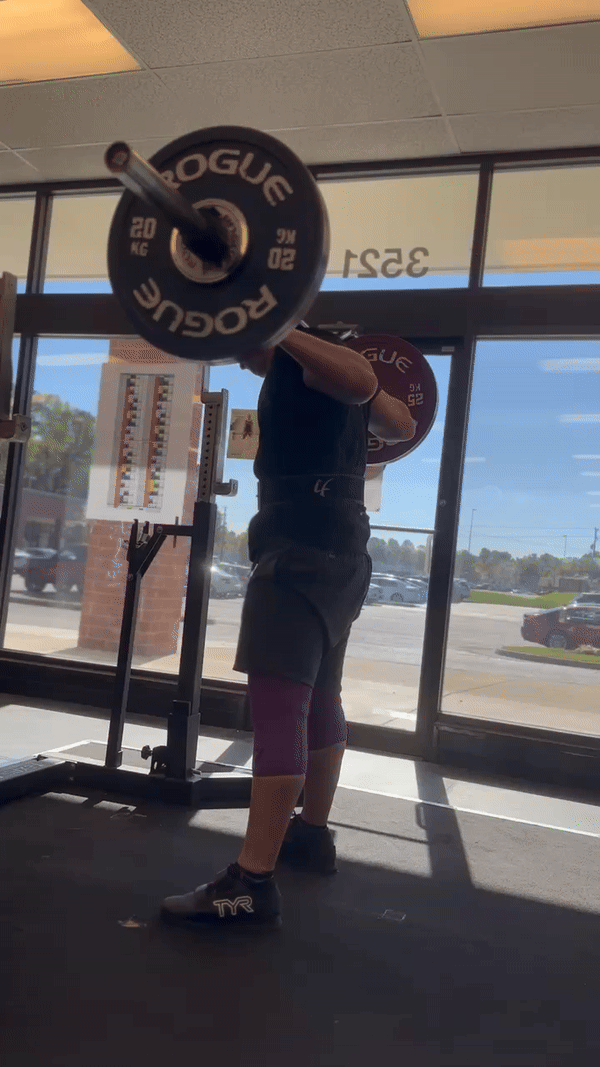
Fortunately, every technique piece you are learning in this article is going to help you to have the bar over the center of your foot the whole time.
Keep your knees in line with your toes
Remember how earlier I talked about how your toe angle should match your knee angle when you’re setting your feet?
As you squat, you should maintain that angle.
One cue I like to use with my online coaching clients is to corkscrew your feet into the floor.
Imagine there is a towel in between your feet, and without actually moving your feet, you’re actively trying to spread the towel apart.
This will help you ensure that your feet don’t roll to either side, which can be a very common cause of your knees coming inwards, and out of line with your toes.
I also want to mention that a common misconception is that your knees cannot pass your toes.
This is completely false, and as long as your heel stays planted on the floor, your knees passing your toes is perfectly fine.
Drive Your Shoulders Up Into The Bar
Driving your shoulders into the bar is a cue I like to use to to make sure that your body doesn’t fold over as you squat.
You can see this here from some early videos of my online coaching client and powerlifting athlete Christine.
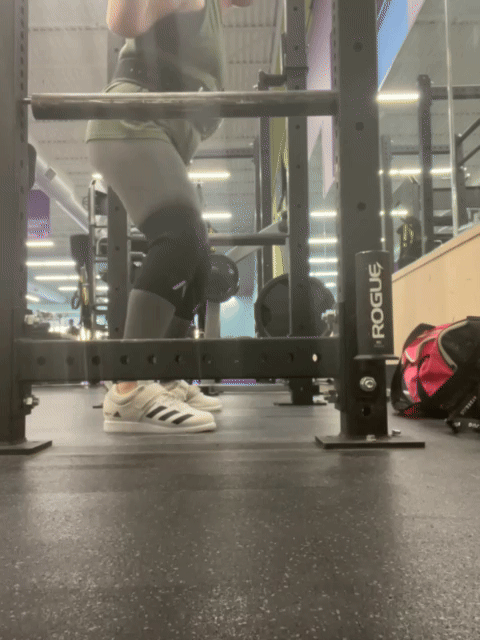
The first thing you’ll probably notice, is that as she initiates her ascent, her hips shoot up, and she’s no longer moving her knees and hips at the same time.
If you have a really keen eye, you might notice the second thing, which is her bar path becomes completely out of whack.
She has to use extra energy in order to right herself to keep from toppling over under the weight of the bar.
This can be due to weak muscles elsewhere in the chain, but most of the time, it’s going to be a technique issue.
In Christine’s case, it was an issue with technique, and the simple cue of “drive your shoulders into the bar” helped her keep her hips and knees moving at the same time.
It helped her keep her chest higher throughout the movement, and keep from folding over.
And best of all, it got her to be able to squat considerable more weight.
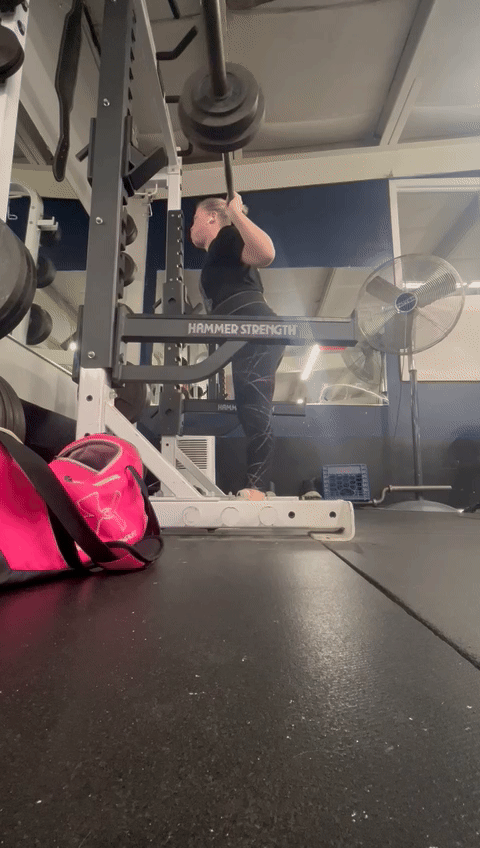
Step 8 – Rack
You did it! You squatted the bar, and you even stood up with it.
The bar didn’t crush you.
There’s only one problem, you still have this weight on your back, and you need to put it down.
While this may seem like a very simple step, it can be easy to screw up.
The trick I like to use with this is instead of looking side to side to try and find the hooks to rack the bar back onto…
Instead, walk to bar directly against the rack, and feel that both sides have hit the rack.
Then you can drop the bar onto the hooks, because you know both sides of the bar are already up against the rack, and not going anywhere
How To Do A Barbell Back Squat: Some Nuance You Should Know
Low Bar Squat vs. High Bar Squat
This is a topic that could probably use it’s own separate article.
I don’t have one just yet.
For now, I’m going to give you an overview on the difference between the low bar back squat and the high bar back squat.
The most obvious difference is where the bar sits on your back.
As mentioned way back at the beginning, the high bar squat rests the barbell across the top of your shoulders.
The low bar back squat rests the barbell across your rear delts.
But that’s not the only difference, because where you place the bar significantly changes how the movement is performed.
It changes what muscles activate more, it changes your posture in the squat, and it changes how much weight you can lift.
Who knew a matter of a few inches of bar placement can have such an impact.
High Bar Squat
With the high bar squat, the bar sits higher on your shoulders, which allows for a more upright posture.
Remember how the bar needs to stay over the middle of your foot at all times?
Well as you sink down into the squat with the bar up higher, it’s easier for you to maintain the upright posture while keeping the bar over your midfoot.
The upright posture is going to cause you to drive your knees forward more, which brings the knee joint further away from the bar.
The more horizontal distance between the knee joint and the bar, the greater demand it is going to place on your quadriceps.
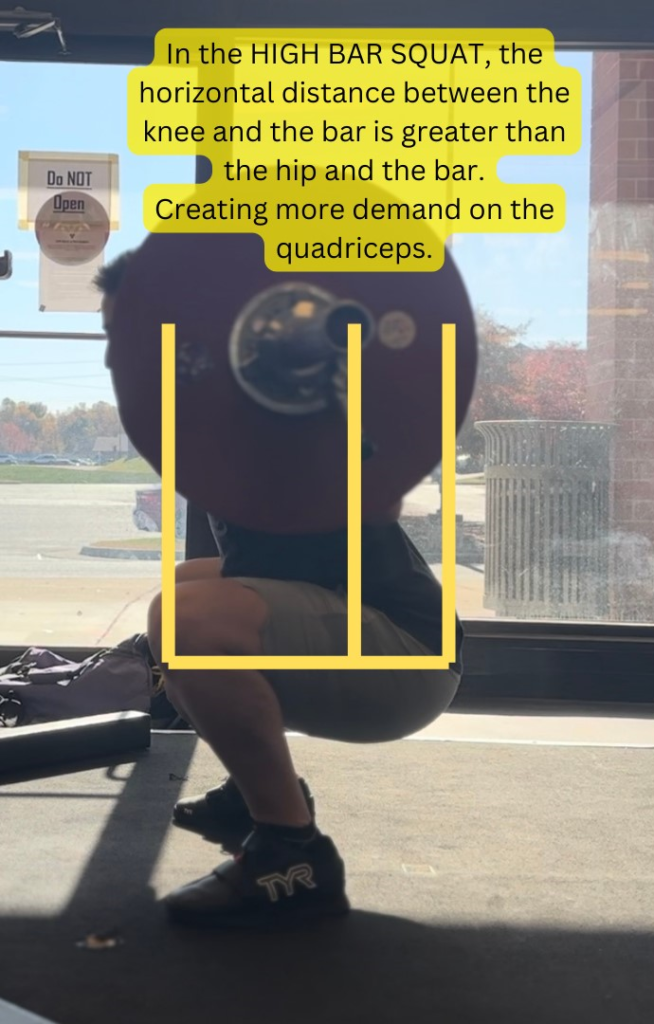
This makes the high bar squat more of a quad dominant exercise, and if you want to grow size and strength in your quads, it’s a great variation.
It is also a great variation if low bar squatting just doesn’t feel right for you.
Low Bar Squat
The low bar squat sits lower on your shoulders, which forces most lifters to lean forward more to maintain the bar over their midfoot.
Since you have to lean forward more, this creates more horizontal distance between the hips and the bar.
This places a greater demand on your posterior chain, otherwise known as all the muscles on the back of your body (glutes, hamstrings, spinal erectors, etc).
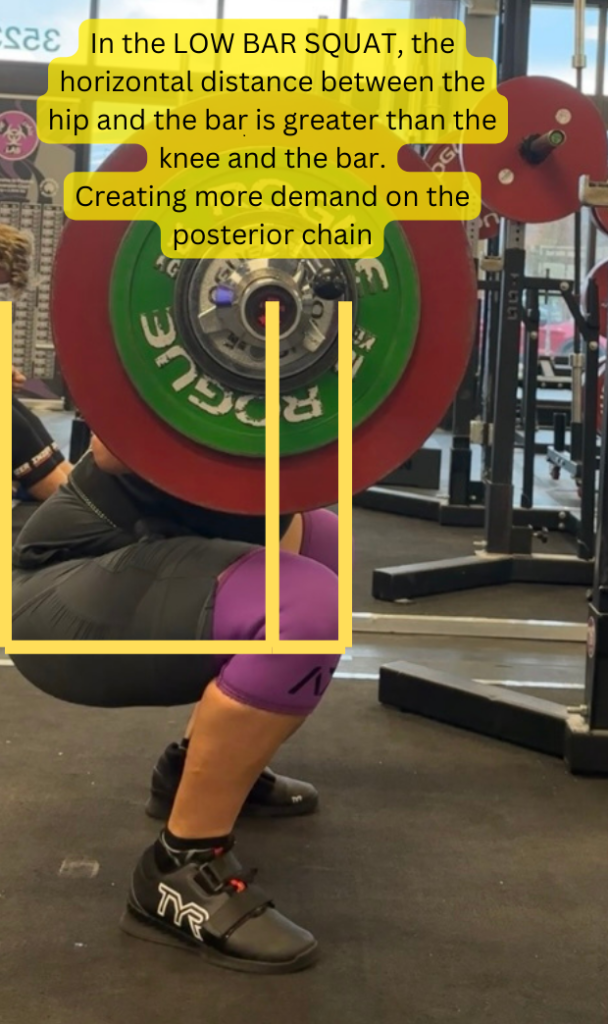
This makes the low bar squat more of a glute dominant exercise, and if you want to grow size and strength in your glutes, it’s a great variation.
It’s also a great variation if high bar squatting just doesn’t feel right for you.
Most lifters can lift more with the low bar squat than the high bar, as the posterior chain generally has more potential for strength than quads.
However, there are always exceptions to the rule.
Squat Anthropometry
Anthropometry is a super fancy word to describe measurements and proportions of the human body.
Everyone has different limb proportions, and in the squat, variation between people can make two squats look completely different, yet both are correct.
When it comes to the barbell back squat, the three areas to look at are at the lower leg, the upper leg, and the torso.
Torso length
- This refers to the length of your upper body, from the shoulders to the hips.
- Individuals with a longer torso may experience more forward lean during a squat, affecting the angle of their back.
- Those with a shorter torso might find it easier to maintain an upright position during a squat.
Upper Leg Length
- Upper leg length is the length of your thigh bone (femur), from the hip to the knee.
- Individuals with longer upper legs may need to lean forward more to balance the barbell over their midfoot.
- Shorter upper legs relative to the torso may allow for a more upright squat position.
Lower Leg Length
- Lower leg length refers to the length of your shin bone (tibia), from the knee to the ankle.
- Individuals with longer lower legs will have more forward knee movement in a squat..
- Shorter lower legs may have a different impact on knee movement and positioning during a squat.
For a more detailed overview on this topic this video by Dr. Brian Bochette explains this very well.
The most important takeaway from this, is that not everyone’s squat will look identical.
If you have a short torso, short lower leg, and a longer lower leg, your squat will be more upright.
If you have a long torso, long upper leg, and short lower leg, your squat will be leaned forward more.
Neither of these are wrong, it’s just the hand you are dealt.
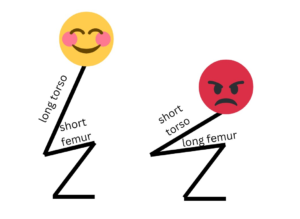
How To Do A Barbell Back Squat: Safety Tips
As with anything you do in the gym, there is a small amount of risk. But if you’re smart, and do everything you can to maximize your safety, the risk is extremely low.
Spotting
If you overestimate how much you can barbell back squat, you need a way to get out of it, in case you can’t stand back up.
This is where the role of a spotter comes into play.
The spotter can either be played by a person, multiple people, or the safety arms on your squat rack.
If you’re squatting with other people, you can have one person stand behind you.
In an emergency, they can grab your shoulders from behind, and assist you in getting back up.
You can also have one person stand on each end, and grab the plates to assist you back up.
If you’re squatting by yourself, setting the safety arms on your squat rack will help if you can’t get back up.
Set the arms just below what the bottom of your squat would be, and you can sit down and the arms will catch the bar.
I detail exactly how do this in this quick video clip
How To Do A Barbell Back Squat: Closing Thoughts
Phew, that was a lot of information!
Like I said, this is the most comprehensive guide on the internet on how to barbell back squat.
So, I understand if the amount of information you’ve just received has overwhelmed you.
It’s important to remember that you’re not going to remember every single detail next time you go in to squat.
And even if you do remember every single detail, you’re not going to get it right the first time.
But, if you can use the information you’ve learned here to continuously improve, then this article has done its job.
Feel free to review the step by step process on how to barbell back squat over and over again.
If you found this guide helpful, but are looking for a more individual approach to perfecting not only the squat, but other lifts too, I am accepting new clients for online coaching.
Click the link above and we can have your lifts looking beautiful and stronger than they’ve ever been before.
Talk soon!
Nick
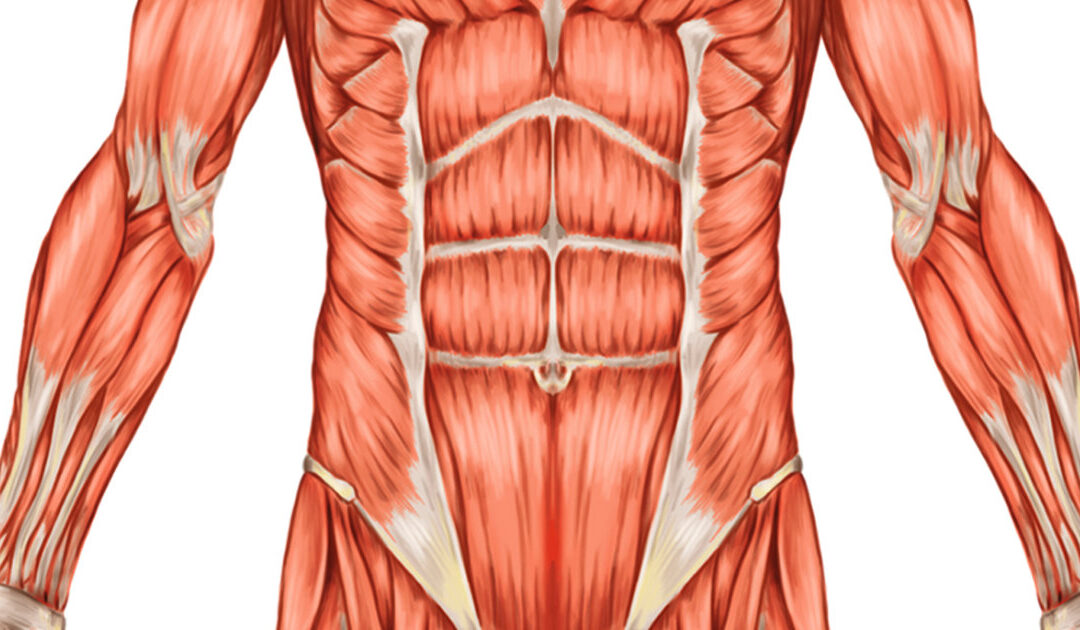
by Nick Anderson | May 2, 2023 | Powerlifting
If you’ve ever been lifting in a commercial gym, you’ve probably heard a trainer in there with a cutoff tee shouting “brace your core!”, with absolutely no context of how to do it.
Or maybe you’ve heard a trainer in an exercise video telling you to draw your bellybutton in to “engage your abs”, which just happens to be the exact opposite of bracing your core.
In this article I’m going to teach you exactly how to brace your core for lifting.
We are going to talk about why it’s important, and what it does to level up your lifts.
How To Brace Your Core For Lifting
Why Brace Your Core In The First Place?
Safety
How many times have you heard of someone hurting their back deadlifting or squatting?
A lot of times this is due to a lack of bracing, which causes spinal instability,
By properly bracing your core, your diaphragm contracts and presses down into the empty space of your abdominal cavity, and creates pressure to support and stabilize the spine.
This is called Intra-abdominal pressure (IAP), and is a vital piece of any heavy lift.
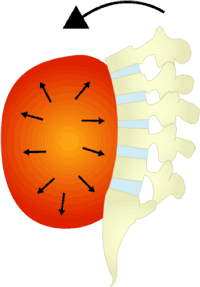
Think of your abdominal cavity like a water bottle.
If you have an empty water bottle, and you press down on the top of it, its going to instantly flatten.
If you take that same water bottle that is filled, and press down on it, it is supported and stable.
Now imagine that with a barbell on top of your back, crushing and compressing your spine, with an empty abdominal cavity. As you increase load, if you do not brace your core, it will flatten like an empty water bottle.
If you fill that abdominal cavity with pressure, it will stay strong under the heavy load.
This is why bracing your core is so important.
Strength
Safety should be the first and foremost concern of your lifting. But now that that’s out of the way, we can talk about the fun part. How this makes you stronger.
Creating intra-abdominal pressure creates a stable foundation for the body to perform heavy lifts. By creating this stable foundation, the body can produce more force and power, which will be directly translated into how much weight you can load on a barbell.
By creating strong IAP, force is transferred more efficiently throughout the body to your muscles and joints. The increased pressure in your abdominal cavity pushes against the walls of your abdominal cavity, which presses against the organs and muscles in the area. The pressure created here transfers to the spine, which is stabilized by the surrounding muscles.
Creating more IAP helps you to recruit more muscle fibers and generate more force. More muscle fibers are recruited from the abdominal muscles, the pelvic floor, the and the back muscles. More muscle recruitment means more force exerted. Thus you generate more strength gains.
You can think of intra-abdominal pressure like putting on a superhero suit. Without it, you are weaker, more vulnerable.
With IAP, you’ve put on your supersuit, and it has made you stronger. The suit is made up of the muscles in your abdomen, back, and pelvis that work together to create superhuman pressure, to allow you to lift heavier things.

How To Brace Your Core For Lifting
Breathing
So now you know the basics of IAP, let’s discuss how to apply it.
Let’s walk through an exercise you can do right now to first get the breathing technique down.
- Lay down on your back with your knees bent and feet flat on the floor. Place one hand on your chest and the other hand on your belly.
- Take a few normal breaths and notice the movement of your hands. You should feel your chest and belly rise and fall with each breath.
- Now, take a deep breath in through your mouth and focus on expanding your belly with air, while keeping your chest relatively still. You should feel your belly rise and your hand on your belly move up.
- As you exhale, focus on contracting your abdominal muscles and pushing the air out, while keeping your chest still. You should feel your belly fall and your hand on your belly move down.
- While maintaining the bracing sensation in your core, take a few more breaths, feeling the difference between normal breathing and breathing with IAP.
By laying down and feeling the movement of your hands on your chest and belly, you can more easily differentiate between normal breathing and breathing with IAP. By focusing on expanding your belly with air and contracting your abdominal muscles, you can create the necessary intra-abdominal pressure for lifting. Practicing this technique will help you to improve your core stability and increase your strength and safety during lifting.
Pushing
Now that you’ve got the breathing portion, let’s focus on how to engage the adbominal muscles.
Remember that engaging your abdominal muscles is not pulling your bellybutton in. In fact it’s the opposite.
You want to push your abdomen out.
Let’s walk through another drill on how to do that.
- Stand tall and place your thumb on your lower back, and your fingers on your belly.
- Imagine that someone is about to punch you in the stomach, and engage your abdominal muscles by pressing your belly into your fingers.
- You should feel a tightening sensation in your core muscles, including your abs, obliques, and lower back.
- Try to maintain this tension while still being able to breathe normally.
- Hold this position for a few seconds and release, repeating the process until you feel comfortable with engaging your abdominal muscles.
Putting it All Together
Now that you have learned the proper breathing and pushing techniques, it’s time to combine them to brace your core for lifting.
Start by taking a deep breath in through your mouth, expanding your belly with air, and pushing your abdomen out. This should create the necessary intra-abdominal pressure for lifting.
As you lift the weight, continue to push your abdomen out and maintain the bracing sensation in your core. Exhale as you reach the top of the lift, and inhale before you the weight back down.
Remember to engage your core muscles throughout the entire lift, from the start to the finish. Practicing this technique will help you to improve your core stability, increase your strength, and prevent injury during lifting.
Reset that brace before the start of every single rep.
How To Brace Your Core For Lifting
When To Brace Your Core
Now that you’ve learned to brace properly, we need to discuss when to do it, and at what intensity.
One thing to learn is that bracing your core is more of a dial than an on/off switch. You can brace your core at an intensity of 10, or you can brace it a little at an intensity of 3.
If you’re doing a more accessory/isolation type exercise, you may want to dial the switch back to a 2. But if you’re doing a max effort deadlift, you’re going to want to turn that dial to 11.

Compound Exercises
Compound exercises are exercises that involve multiple joint movements, and more than one muscle group. They require a high degree of strength and stability in your core to perform the exercises safely and effectively. Some compound exercise examples are: squats, deadlifts, bench press, overhead press, rows.
When doing a compound exercise, you should brace your core throughout the entirety of the movement, from the moment you begin the lift, to the moment you end. This will stabilize the spine, engage the abdominal muscles, and help you exert maximal force.
When performing exceptionally heavy sets, you should turn the brace your core dial all the way up. When your dial is all the way up, we will be using the Valsalva maneuver.
Using The Valsalva Maneuver
The Valsalva maneuver is a breathing technique that involves taking a deep breath and holding it while bearing down against a closed airway by pressing the tongue against the roof of the mouth. This creates a significant amount of intra-abdominal pressure (IAP), which can help stabilize the spine and support heavy lifting. This creates a “locked-in” feeling, making your core muscles more rigid and stable. By doing so, it can increase the amount of weight you can lift and reduce the risk of injury.
When you perform the Valsalva maneuver, you essentially turn your core bracing dial up to 10, creating a maximum amount of intra-abdominal pressure. This can be useful during exercises that require maximal effort, such as a 1-rep max deadlift, where you need all the stability and support you can get to lift the weight.
To perform the Valsalva maneuver, take a deep breath in and hold it while you contract your abdominal and pelvic floor muscles. The sensation should be similar to when you are bearing down to take a poop. Extremely important… don’t actually poop. Continue to hold your breath and the bracing sensation throughout the lift, and exhale once the weight has been successfully lifted or moved.
It’s worth noting, however, that performing the Valsalva maneuver carries some risks, especially if you have a medical condition that affects your heart or blood pressure. Holding your breath can increase your blood pressure and heart rate, which can be dangerous if you’re not used to it or if you have an underlying condition.
Setting The “Core Brace Dial” Lower
Not every compound lift requires you to turn your brace all the way up to 10. If you are doing a max effort repetition of one, on a barbell deadlift or squat for example. Yes, turn it up to 10. Even on a heavy set of 3, yes turn it up to 10.
But let’s say you’re doing a set of 10 goblet squats. Your core brace dial should be turned up to a moderate level. This means you should engage your core muscles enough to maintain proper form and stability throughout the movement, but not to the point where you are holding your breath or straining excessively. You should still take a large breath in, and push your abdominal muscles. But you should be breathing relatively normal.
The size of the brace should match the size of the intensity of a single rep for each set. Your heavy set of 3 will require a big brace, your lighter set of 10 will require a moderate brace
Accessory/Isolation Exercises
When doing accessory/isolation exercises, you won’t need to brace as hard as you would for a max effort deadlift.
But a small degree of bracing is still going to help provide stability through the spine, and help you to exert more force.
If you’re doing a set of bicep curls for example, you may want to still push your abdominals out, like Mike Tyson were about to come punch you in the stomach, but you will want to breathe normally.
Pushing through your abdominals will help keep the spine neutral and stiff, and reduce any swaying through the spine that can stress the low back.
When doing a set of lunges, or Bulgarian split squats, you will need to brace your core through pushing your abdominals out, to help maintain single leg balance. But you don’t need to breathe in so deep that you turn blue in the face. Don’t be the person passing out from holding their breath doing a bicep curl or a lunge.

How To Brace Your Core For Lifting
Using A Lifting Belt
Should I Use A Lifting Belt?
Using a lifting belt is a personal choice, and it depends on various factors such as your fitness level, the type of exercise you’re doing, and your personal preference. A lifting belt can provide support and help maintain proper form while performing heavy lifts. It can also help to reduce the risk of injury to your lower back and spine by stabilizing the torso.
However, using a lifting belt doesn’t replace the need for proper form and technique. It’s crucial to learn proper form and technique for each lift before incorporating a lifting belt into your routine. The very first thing you need to do before even considering using a belt, is to learn the proper bracing technique. The belt provides you a firm object for your abdominal muscles to push against.
It only works if you are creating the necessary intra-abdominal pressure to push into it. It does not magically provide protection to your lower back just by strapping the belt on and hoping for the best. It is a tool to use to help get a stronger brace than one you already have without the belt.
If you have mastered the skill of bracing, then a belt can be a useful tool to provide additional support and stability during your heavy lifts. But it doesn’t need to be used all the time.
When To Use A Lifting Belt
A lifting belt should be used for exercises that place significant stress on the lower back and core muscles, such as squats and deadlifts. These lifts require the use of multiple muscle groups and can cause significant stress on the spine.
If you’re performing exercises with weights that are less than 80% of your 1-rep max, you may not need to use a lifting belt. However, if you’re lifting heavy weights that are above 80% of your 1-rep max, a lifting belt can help to provide additional support.
You should not rely solely on a lifting belt for support. You should still focus on developing proper form and technique and building core strength.
How To Use A Lifting Belt
When using a lifting belt, it’s important to position it correctly. The belt should be placed snugly around your waist, just above your hip bones. Make sure the belt is tight enough to provide support but not so tight that it restricts your breathing.
When lifting, take a deep breath and push your stomach out against the belt, you should feel the tightness of the belt as you push out into it. This will help to create intra-abdominal pressure, which will stabilize your spine and protect your lower back. Maintain this pressure throughout the lift, and exhale at the top of the lift.
Exercises To Strengthen Your Core
Compound Exercises
The absolute best way to strengthen your core bracing, is to practice it.
By doing compound lifts like squats/deadlifts and practicing proper bracing, you are building your core strength, and placing demand on the abdominal muscles.
These exercises require a strong core to maintain stability throughout the movement.
Isolation Ab Exercises
The abs shouldn’t be worked just from compound exercises alone, it’s important to include exercises that directly target your abs as well.
Squats and deadlifts are amazing exercises, that challenge your core strength and stability. They work your core isometrically. Meaning that your core does not move throughout the movement, and it’s job is to stay as stiff and stable as possible. But if you want a well rounded and strong core, you’re going to have to work your core through movement as well as isometric contractions.
That’s where more targeted abdominal work comes in.
Here’s some examples you can try for a well-developed and strong core.
Anti Extension
These exercises focus on preventing your lower back from arching excessively, which can cause strain or injury to the spine. Examples include:
Flexion
These exercises target the muscles on the front side of your body, which can help to improve your posture and overall core strength. These exercises work by moving the spine forwards. Examples include:
- Crunches
- Cable Crunches
- Reverse Crunches
Rotation
These exercises work to strengthen the muscles on the sides of your body, which can improve your stability and prevent injury. These work by resisting the movement of your spine bending sideways. Examples include:
- Bicycle crunches
- Russian twists
Anti Extension
These exercises focus on preventing your torso from rotating or twisting, which can help to improve your stability and prevent injury. Examples include:
- Pallof Press
- Cable rotations
Anti Lateral Flexion
These exercises target the muscles on one side of your body while preventing your torso from bending to the opposite side. Examples include:
- Side Plank
- Suitcase carry
How To Brace Your Core For Lifting: Final Thoughts
Now you’ve learned how to brace your core for heavy lifting by creating intra-abdominal pressure. Using the methods of breathing properly, and engaging your abdominal muscles, you’ve learned how to brace to exert as much force as possible, and keep yourself as safe as possible. A winning combo!
You’ve learned when and how much to brace your core for every applicable situation.
You’ve learned to push your abdomen out, and not draw your bellybutton in.
Now you’re ready to go slay your biggest of lifts! Let’s practice these techniques and be your strongest self yet.
Any questions, drop a comment below, or e-mail me at [email protected] and I’m happy to help.
Talk soon!
Nick
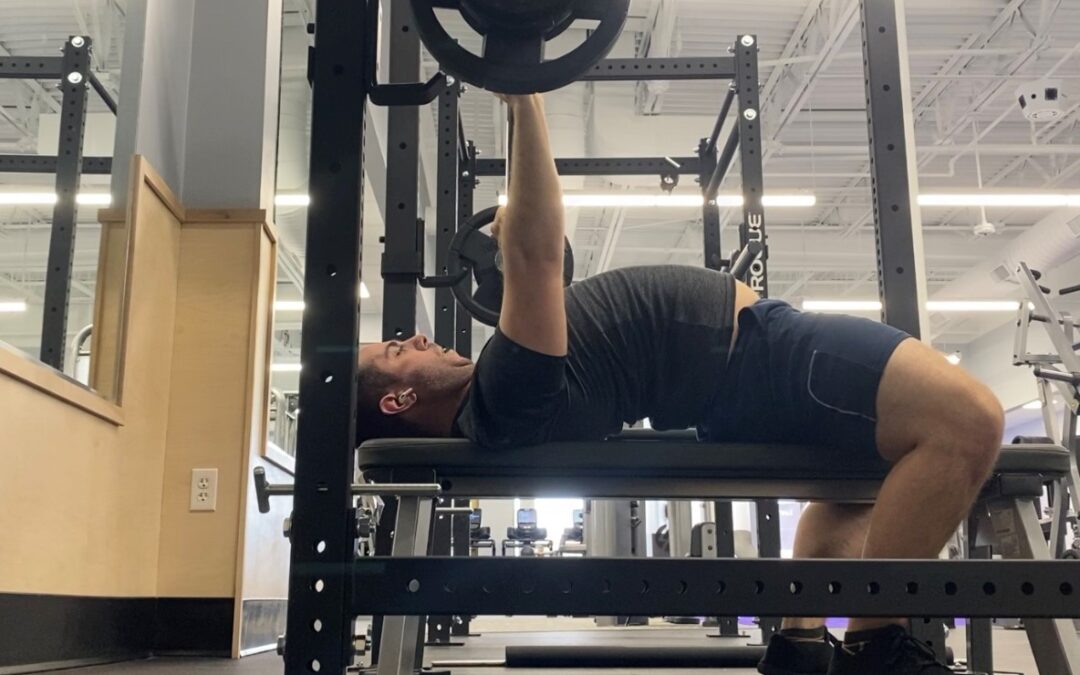
by Nick Anderson | Apr 29, 2022 | Powerlifting
You may have seen some lifters go into a gym, and set up for a bench press, with an arch that would make The Exorcist look like a kids movie.
Maybe you shrug it off and think that it’s weird, and then carry on with your workout.
Or maybe you’ve found this article, since you were wondering what the hell they were arching their back like that for.
And wondering if it’s a safe an effective way to bench press.
Let’s talk about it, and by the end of this article, you might want to consider arching your back when you bench.
An Arched Back Is Safer For Your Body
Whenever you bench press you want to have your shoulders pinched together and pulled down (scapular retraction)
If the shoulders are not pinched together and down, this is going to cause your shoulder to pop forward when you bench, which is going to place a lot of stress on your shoulder joint, and rotator cuff musculature. Which is one of the most common areas of injury during the bench press.
By pinching your shoulders down and back, this is going to create a natural arch your thoracic spine (upper back), and will allow your pectoral muscles and triceps to handle more of the load, while placing less stress on the shoulders.
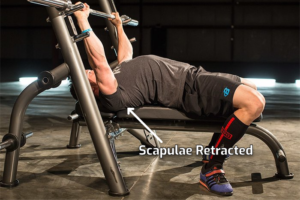
So what happens when you don’t arch in the bench press?
When you don’t pull your shoulders back, the front part of your shoulder will have to come forward.
And when we get to the bottom of the movement, the shoulder being pulled forward is going to place a lot of pressure on your joint, which over time, will lead to discomfort and injury.
Here’s a video of what that looks like. Watch the shoulder pop forward.
Your Spine Isn’t Loaded In The Bench Press
At first look, it looks like an arched back in the bench press may contribute to a spinal injury.
To the untrained eye, it can look dangerous.
But let’s talk about how the two ways the spine can get injured, axial loading and shearing force.
An axial load simply means a load that compressed, in the case of the spine, from top to bottom, like when a barbell is compressing your spine in a back squat.
A shearing force is where the vertebrae in the spine may be moved in opposite directions.

An axial load would occur on the spine in say, an overhead press.
Since the barbell is overhead, the force is pushing down on the spine.
And if you arch your back here, that would be quite dangerous.
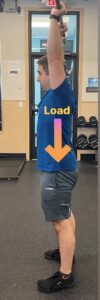
But you arch in a bench press, you’re not getting the same load on the spine.
Since the load is perpendicular to the spine, that’s not where the load is being handled,
Since the spine doesn’t get loaded top-down in the bench press, it is safe for your spine.
And since creating an arch positions the bar over the upper back and shoulders, there’s even less tension on the lower back.
It’s A Stronger Bench Press Position
Full Body Tension
By arching your back, you can create more tension throughout your body, and creating more tension means you can more more weight.
So if you want to build a really big bench press, arching your back to create as much tension as possible is ideal.
Creating full body tension makes the bench press become more than just a chest exercise.
It becomes a full body movement, and the more muscles you can recruit the stronger you will get from top to bottom.
Leg Drive
Leg drive is when you’re pushing the weight off your chest, you are driving your legs and feet into the floor.
This helps drive both your hips, and your shoulders into the bench, producing more force output.
If you use leg drive properly, if you weren’t holding the bar, you’d slide yourself right off the bench.
Using leg drive naturally accentuates a bench press arch, which allows you to push more weight in this stronger position.
Can A Bench Press Arch Be Dangerous?
Actually yes.
If your butt leaves the bench, then force is placed on the spine.
The shoulder and butt act as an anchor point.
And if the butt is not in contact with the bench, then the spine does get the axial load we talked about above.
So if you are benching with proper form, then no it is not dangerous.
As with any exercise, if you are doing it with improper form, then yes, it is dangerous.
Use good form, always.
When arching in the bench press you want to maintain 4 points of contact at all times.
The head, the shoulders, the butt, and the feet.
When the weight gets heavy, do not lift any of those things up, or you are at risk for injury.
How Much To Arch Your Back When You Bench Press
It all depends on your goal.
If your goal is to get to your maximum strength with the bench press, then practicing your arch is going to be extremely helpful for you.
This is going to lessen the range of motion needed to complete the movement. And it’s going to allow you to create as much force as possible.
If your goal is to maximize muscle growth with the bench press, then a significant arch is not necessary. However, you still want to keep your shoulders pinched down and back to keep them safe, and maximize activation of the chest.
Why Powerlifters Arch Their Back In The Bench Press
Despite all the safety and efficiency reasons lifted above, powerlifters arch their back in the bench press to help them lift more weight in competition.
This is the position that can create the most tension, leg drive, and also elevate the chest higher, so the touch point makes for less range of motion.
In a powerlifting competition, the goal is to lift as much weight as possible for one rep, so achieving this high arch is fundamental to the sport.
Since this technique is completely within the rules of powerlifting, most lifters will adopt this technique.
If powerlifting
is something you’re interested in, grab a FREE copy of my First Powerlifting Meet Guide.

Bench Press Arch: Final Thoughts
Despite it looking dangerous, it’s actually not.
Looks can be deceiving, and the bench press arch is the safest position to bench press from.
So next time someone tells you that arching your back is “cheating” or “unsafe”, send them this article.
Much love,
Nick



 Here’s what you’ll get:
Here’s what you’ll get: